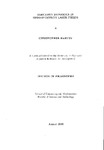Electron Dynamics in High-Intensity Laser Fields
| dc.contributor.supervisor | Heinzl, Thomas | |
| dc.contributor.author | Harvey, Christopher | |
| dc.contributor.other | School of Engineering, Computing and Mathematics | en_US |
| dc.date.accessioned | 2011-01-06T11:45:43Z | |
| dc.date.accessioned | 2013-09-10T10:40:30Z | |
| dc.date.available | 2011-01-06T11:45:43Z | |
| dc.date.available | 2013-09-10T10:40:30Z | |
| dc.date.issued | 2010 | |
| dc.date.issued | 2010 | |
| dc.identifier | 287075 | en_US |
| dc.identifier.uri | http://hdl.handle.net/10026.1/301 | |
| dc.description | Access to the full-text thesis is no longer available at the author's request, due to 3rd party copyright restrictions. Access removed on 28.11.2016 by CS (TIS). | |
| dc.description | Metadata merged with duplicate record (http://hdl.handle.net/10026.1/1627) on 20.12.2016 by CS (TIS). | |
| dc.description.abstract |
We consider electron dynamics in strong electromagnetic fields, such as those expected from the next generation of high-intensity laser facilities. Beginning with a review of constant classical fields, we demonstrate that the electron motion (as given by the Lorentz force equation) can be divided into one of four Lorentz invariant cases. Parameterising the field tensor in terms of a null tetrad, we calculate the radiative energy spectrum for an electron in crossed fields. Progressing to an infinite plane wave, we demonstrate how the electron orbit in the average rest frame changes from figure-of-eight to circular as the polarisation changes from linear to circular. To move beyond a plane wave one must resort to numerics. We therefore present a novel numerical formulation for solving the Lorentz equation. Our scheme is manifestly covariant and valid for arbitrary electromagnetic field configurations. Finally, we reconsider the case of an infinite plane wave from a strong field QED perspective. At high intensities we predict a substantial redshift of the usual kinematic Compton edge of the photon emission spectrum, caused by the large, intensity dependent effective mass of the electrons inside the laser beam. In addition, we find that the notion of a centre-of-mass frame for a given harmonic becomes intensity dependent. | en_US |
| dc.language.iso | en | en_US |
| dc.publisher | University of Plymouth | en_US |
| dc.subject | Laser | en_US |
| dc.subject | Strong field QED | en_US |
| dc.subject | Covariant numerics | en_US |
| dc.title | Electron Dynamics in High-Intensity Laser Fields | en_US |
| dc.type | Thesis | |
| plymouth.version | Full version | |
| dc.identifier.doi | http://dx.doi.org/10.24382/1563 |
Files in this item
This item appears in the following Collection(s)
-
01 Research Theses Main Collection
Research Theses Main



